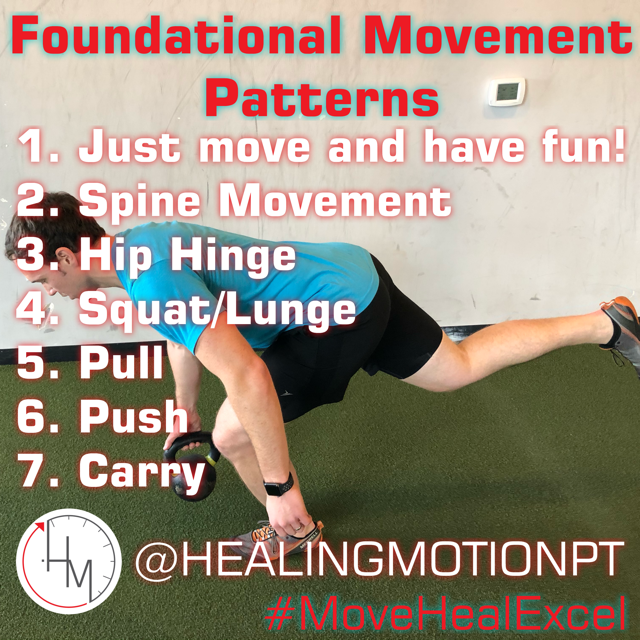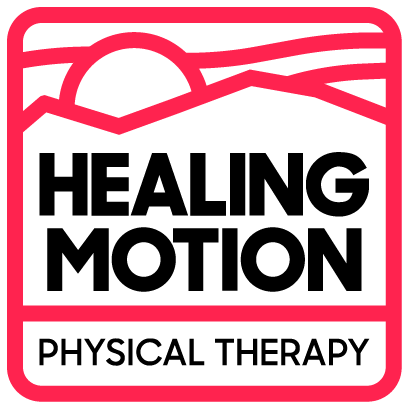Look anywhere online these days and you can find a million and one movement and exercise experts telling you how weak you are and how much you stink at movement. I’m here to tell you, you are strong, but you can be stronger. You move fine, but you can move better. As complex as movement is, most movements in life can be broken down into these 7 movement patterns.
Please note #1! JUST MOVE AND HAVE FUN! This is by far the most important thing we can do. If we then do the next 6 patterns better, we move better, feel better, and tend to have more fun with movement!
Also, PLEASE remember that exercise and activity is just our 6th Pillar of our 6 Pillars of Health. You can have these 7 Foundational Patterns dialed in, but if your other 5 Pillars aren’t, you likely won’t have much joy or fulfillment. Learn more about our 6 Pillars of Health here.
Follow along below as we break down each of these movement patterns.
You can also check out our Strength Progression Chart to visualize the progressions all at once.

1. Just Move and Have Fun!
The World Health Organization (WHO) recommends:
- Children be active for 60 minutes of moderate to vigorous activity per day. More info here.
- Adults be active for 150 minutes of moderate activity per week (30′, 5 days per week average). More info here.
- They also recommend strengthening at least 2x/week and that if you can incorporate more than 150′ including vigorous activity, you will have more benefit
Heart disease is the number one leading cause of death in the world. It accounts for >20% of deaths. Other leading causes of death are stroke and other organ failure issues. Learn more about this from the CDC. While some of these can be due to genetics, the vast majority can be PREVENTED. What’s the number one way to prevent them you ask? EXERCISE. MOVING YOUR BODY.
Exercise and movement are also key to helping improve stress, depression, and overall mental health. You get the picture. Movement and getting your heart rate up is important. Well rounded health beyond just movement is important too – check out our 6 Pillars of Health Blog for more info.
Now that you’re moving, we can make your movement better and more fun by learning to move better with the other 6 foundational patterns.
2. Spinal Movement
The key to spinal movement is moving your spine when you want to, and keeping it “neutral” when you don’t want to! All movement requires us to either move our spine, or keep it steady. This why improving our spinal movement is KEY to all movement.
The basics of this is to own the pelvic tilt. Once you own that, you can work through our core strength progression.
Spinal Movement Key Movement Points of Performance
- Be able to pelvic tilt and control back arching and flattening
- Be able to keep a neutral spine when you want to
- Avoiding back arching or flattening
- Be able to flex, extend, side bend, or rotate your spine when you want to
Check out our Core Strengthening Playlist to start improving your spinal movement!
Pelvic Tilts and Core Strengthening Playlist
Full Spinal Movement Strength Progression Chart here.
3. Hip Hinge
The hip hinge is the ability to do just that, hinge at your hips. The idea is to be able to keep a neutral spine while you move at your hips. This is key to be able to do for bending and lifting. You don’t always have to hip hinge, it is okay to flex your back, but it’s good to know how to hip hinge when you need it with more repetitive tasks or heavier lifting.
Hip Hinge Key Movement Points of Performance
- Spine stays neutral throughout
- Slight knee bend and rest of movement comes from the hips
- Hips move back as trunk hinges forward from hips
- Your pelvis and shoulders should move down and hip together at the exact same rate the entire time
Get going with our hip hinge video and then start applying it with our Hip Strengthening playlist!
How to Properly Hip Hinge
Hip Strengthening Playlist
Full Hip Hinge Movement Strength Progression Chart here.
4. Squat/Lunge
Squatting and lunging are similar to the hip hinge and require a good hip hinge to be done properly, except we bend more at the knees and require more quad strength compared to the hip hinge. This is key for getting down and up from the floor, walking up and down hills and stairs, and lifting things from lower to higher surfaces or setting them down.
Squat/Lunge Key Movement Points of Performance
- Neutral spine, hinge at hip, trunk angle is parallel with shin angle (front shin with lunge); trunk does not lean to either side
- Knees stay in line with toes, stacked perfectly between your hip and ankle
- It is okay for your knees to go over your toes, so long that your feet stat flat (heels don’t lift off (back leg heel does lift with lunge)) and knees stay stacked between hips and ankles
Get going with our How to Properly Squat and Lunge videos and then progress your strength with our Quad Strengthening Playlist.
How to Properly Squat
How to Properly Lunge
Quad Strengthening Playlist
Full Squat/Lunge Movement Strength Progression Chart here.
5. Pull
Moving to upper body, movement can mostly be simplified into pulling, pushing, and carrying. With all these movements, as a general rule, your shoulder blades should follow your elbows. We’ll elaborate on this with our descriptions below.
For pulling the key is to drive the motion with our shoulder blades. As we pull our elbows back, we should drive the movement by squeezing our shoulder blades back and together. The most basic pulling exercise is the row as seen below.
Pulling Key Movement Points of Performance
- Drive pulling movement by squeezing shoulder blades back and together
- Keep the shoulder itself back as well not letting it dip forward
Get going below with learning how to properly pull with the row and progress your strength with our pulling strengthening playlist. Also, check out our shoulder strengthening playlist that also does have some good rotator cuff strengthening exercises to compliment our pulling, pushing, and carrying.
How to Properly Pull
Pulling Strengthening Playlist
Shoulder Strengthening Playlist
Full Pull Movement Strength Progression Chart here.
6. Push/Press
Pushing is another main shoulder movement. We have simplified this to pushing straight forward as well as overhead which is often referred to as a press. Keeping with our “shoulder blade follows the elbow theme” we decided to combine push and press together since the shoulder blades are moving forward or up following the elbows. The key with overhead is that the outside of the shoulder blades rotate up as opposed to shrugging up towards your ears.
Pushing/Pressing Key Movement Points of Performance
- Shoulder blades follow the elbows and drive motion with pushing forward or rotating up
- Active shoulders! Be as long through your finger tips/fists while avoiding too much shrugging of shoulders up into ears
Get going with pushing below. Learn the basics with our pushup and overhead press videos and then improve it further with our Pushing/Pressing Strengthening playlist.
How to Properly Push Forward
How to Properly Push/Press Overhead
Pushing/Pressing Strengthening Playlist
Full Push/Press Movement Strength Progression Chart here.
7. Carry
The last foundational movement pattern is carrying. We carry things all throughout our day. Backpack to school, bag to work, grocery bags when shopping, tools with yardwork, younger kids as we care for them, you get the picture.
Carrying Key Movement Points of Performance
- Slight shoulder shrug up and back
- Keep neutral spine and limit leaning trunk back or side to side
Get going with carrying below!
Full Carry Movement Strength Progression Chart here.
So, that’s it, the 7 Foundational Movement Patterns. Make sure you don’t forget the first one, just move and have fun! Especially with younger kids, movement is more important and form less important. Form becomes more important as we get older. For more exercise ideas for kids, check out our Kid, Teen, Family 15 Minute Workouts. Below is a good gauge of how much to focus on form:
- Sure, there is a “better form” with any exercise, but the main problem in our society is that we DON’T EXERCISE ENOUGH, not that we exercise “wrong”.
- The younger the kid, the less you should worry about their form. Do they have “perfect form” on the playground or playing with their friends? No. This is the consideration when doing exercises where 15 or more reps can be done
- Recommended “form focus” by age
- Elementary Age: don’t even mention form – for the most part
- You can teach these movement patterns and practice them and occasionally pick 1 thing to have them focus on, but just moving and having fun should be the primary focus
- Middle School: pick 1 thing they can focus on for each exercise
- High School and Adults: go ahead and focus more on form; check out our detailed descriptions of each exercise as you need; they should pop up as a link to click on with each video and it will take you to one of our videos describing proper form with each exercise
- Elementary Age: don’t even mention form – for the most part
Now, get going! Move your body and have fun, and work to refine and perform your foundational patterns over time. We will always strive for perfection knowing we’ll never quite get there and that’s okay! For more on this, check out our Better Every Day Blog!
Happy Moving!
Dr. Dane Happeny, PT, DPT, OCS, CF-L1
Doctor of Physical Therapy
Board Certified Orthopedic Specialist
CrossFit Level 1 Trainer

